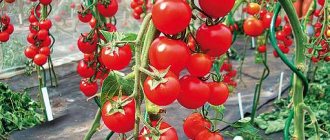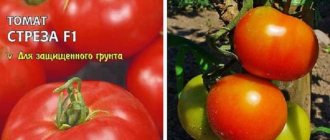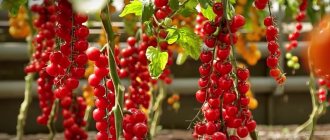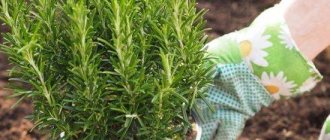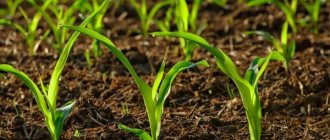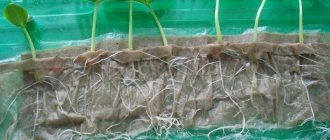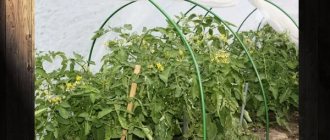Botanical description
The tomato (Lycopersicon esculentum Mill.) is an annual plant belonging to the nightshade family, which also includes the poisonous bittersweet nightshade and belladonna.
| Biological features | Photo |
| The tomato root system consists of a taproot, grows and develops quickly, and is about 1 meter long. Due to processing, in particular picking, the root is shortened, which leads to the formation of more lateral roots (the root system becomes fibrous). The underground part of the bush is located within a radius of up to 60 cm and grows to a depth of up to 90 cm. | |
| The tomato stem is pubescent, grows up to 40-200 cm, erect or lodging. The main stem initially grows vertically, then bends. In some dwarf varieties the bush remains erect. From the leaf nodes of the main shoot, lateral shoots of the first order (stepchildren) sprout, from them - of the second, etc. | |
| Tomato leaves are imparipinnate, grow oval, toothed, pubescent, and emit a characteristic odor. | |
| Tomato flowers appear 50-60 days after germination. They are yellow, bisexual, usually five-petaled, star-shaped. Mostly self-pollinating. It is collected in an inflorescence called a raceme, 5-20 pieces (usually 3-8). Depending on the variety, inflorescences can be single, double or compound. | |
| The tomato fruit is a berry, ripens 6-8 weeks after pollination. Characterized by a variety of shapes, sizes and colors. The color of the fruit depends on the content of pigments in the skin. | |
| Tomato seeds are flat, pubescent, gray-yellow or light brown in color, 3-4 mm long, 2.5 mm wide and 0.3-0.6 mm thick. The seeds are velvety, covered with hairs and small warts. 1 gram contains 300-350 seeds. Germination lasts up to 5 years. |
The nutritional value
Tomato is a very important and valuable vegetable. Tomatoes are consumed fresh, for the production of concentrates, juices, sauces, ketchups, baby food, canned meat and fish, and soups. Tomatoes can also be pickled, canned, dried and dried.
Tomato fruits contain 5-8% dry matter, depending on the variety.
They also contain:
- vitamin C;
- provitamin A;
- B vitamins;
- red varieties contain more lycopene;
- yellow-colored varieties contain β-carotene.
Tomato is a low-calorie vegetable that can be successfully found in every person’s diet. It is not recommended to eat unripe green tomatoes, as they may contain substances that are toxic to the human body.
Varieties
Currently, mainly self-pollinating hybrids are grown. Varieties differ according to the following characteristics:
- duration of growing season:
- very early (95-105 days from germination to fruiting);
- early (105-115 days);
- moderate-early (116-135 days);
- late (after 130 days);
- growth type:
- superdeterminate (dwarf) – stems grow up to 40 cm;
- determinate - stems reach 70 cm, with each shoot ending in an inflorescence;
- indeterminate - have endless stem growth.
- form:
- round;
- flattened round;
- elongated;
- ribbed;
- smooth;
- fruit color:
- yellow;
- orange;
- crimson;
- red;
- black with shades of purple;
- fruit size (according to European standards):
- cherry 15-30 g;
- cocktail cherry 25-40 g;
- with small fruits 50-100 g, diameter 47-57 mm;
- with average fruits 100-150 g, diameter 57-67 mm;
- with large fruits 150-200 g, diameter 67-82 mm;
- with very large fruits 200-1000 g, with a diameter of more than 82 mm;
- usage:
- salad;
- cocktails;
- for canning;
- for the production of tomato juice.
You can read more in the article about Tomato varieties for open ground.
Before a red, juicy and aromatic tomato reaches our table, it must be provided with favorable conditions during the growth period and undergo a series of procedures. Only by knowing how to grow tomatoes correctly can you enjoy the delicious fruits.
Climatic requirements - temperature, air and soil humidity
In our country, due to climatic conditions, tomatoes are grown from May to October. Before growing tomatoes, you need to familiarize yourself with the temperature conditions for cultivating seedlings and adult bushes. Temperature conditions suitable for tomatoes are as follows:
- Temperatures of 2 °C are detrimental to tomatoes.
- Seeds germinate better at 14-16 °C, the optimal temperature is 18-20 °C.
- The tomato grows well with a temperature difference of 8-10 °C between day and night, the most suitable temperatures being 25 °C during the day and 17 °C at night.
- It takes approximately 30°C for flowers to appear and fruit to set.
When it comes to temperature fluctuations, unfortunately, tomatoes are sensitive to both low and high temperatures. A long cold season, unfortunately, can slow down plant growth and cause flowers to drop. On the other hand, on very hot days, when temperatures reach above 30 °C, plants do not produce lycopene, which is responsible for the red color of tomatoes.
It is better to choose a place protected from the wind for growing.
Tomato does not have significant requirements for air humidity, but develops better at a relative humidity of 50-60%. High humidity increases the risk of disease.
Soil moisture is more important for growth. At the initial stage of development of a tomato bush (and when growing seedlings), the soil should contain 70-75% NV, 90% NV when planting seedlings, 80% NV in subsequent stages. There is no need to maintain higher soil moisture, not to mention stagnant water, so as not to provoke the development of fungal diseases and plant death.
A tomato is a plant that requires two factors for proper growth - heat and sun. Therefore, it grows better in sunny places.
When to pick tomatoes
Tomatoes are harvested as they ripen. However, if there is a threat of frost, they can be collected green in advance. You can collect them even if frosts are not expected yet, but the temperature drops below 7-8 degrees. This is necessary so that the tomatoes are not affected by diseases due to low temperatures.
Tomatoes collected in this way will ripen well in 7-10 days. It is desirable that these are large fruits of brown or milky color along with the stalk. They need to be laid out in a box, in one layer, covered with burlap on top and placed in a warm place so that they ripen faster. However, if you want the collected tomatoes to last longer, you need to place them in a cool room.
Soil requirements
Good soil guarantees a high yield. If we want to enjoy delicious tomatoes, we need to provide the plants with the right soil.
Best soils
The tomato grows well in many types of soil. Best soils:
- medium-heavy;
- rich in humus;
- rich in nutrients;
- well heated;
- moderately humid;
- neutral or slightly acidic: pH, pH 5.2-6.5;
- with high porosity and good structure;
- with an abundance of nutrients (see table);
- free of diseases, pests, weed seeds, toxic salts.
Table. Optimal content of macronutrients in soil for growing tomatoes (according to Rumpel)
| Macro component | Optimal content (mg/dm³) | |
| Soil for sowing | Soil for picking and planting | |
| nitrogen | 150 | 250 |
| phosphorus | 80 | 150 |
| potassium | 300 | 350 |
| magnesium | 60 | 100 |
| calcium | 1500 | 2000 |
Determinate varieties grow poorly on light, peaty soils; the best yields are observed on heavy, humus soils.
You can buy ready-to-use soil from a trusted source, or prepare the substrate yourself accordingly.
Soil preparation
To produce peat soil you will need:
- garden peat;
- chalk or dolomitic lime;
- multicomponent fertilizer.
Organic peat is acidic and therefore requires deacidification to a pH of 6.0-6.5. To do this, add chalk or dolomitic lime - usually 8 kg per 1 m³ of peat, the soil must be mixed well. Before decontamination, it is recommended to supplement the soil with nutrients using one of the multi-nutrient fertilizers, for example, azofoska, also keeping in mind micronutrients.
The deoxidation process can cause some elements, mainly phosphorus and potassium, to become insoluble forms and become unavailable to tomatoes. Peat soil prepared by hand can be used the next day.
A good soil can be created from a mixture of:
- clay soil (from a clover or alfalfa field fertilized with manure 100-150 t/ha);
- peat;
- coarse sand.
The mixture is made in a ratio of 2:1:1 for sowing or 7:4:1 for picking and planting. After mixing, add 2 kg/m³ of chalk and multi-component fertilizer according to the instructions on the package. When preparing seed soil for tomato seedlings, there is no need to use fertilizer.
The prepared soil is suitable for use only after decontamination.
In the case of growing seedlings in an apartment, in containers, you can use soil purchased at a garden store - a universal mix is better.
Soil disinfection
The soil can be disinfected chemically or thermally, the latter method is used more often. For thermal disinfection, steam is used to heat the soil to 95-100 °C - the treatment should last 20-30 minutes. The disadvantage of treating soil with steam is an increase in the concentration of the ammonium form of nitrogen in the soil, which is harmful to tomato seeds and plants in the initial growth phase, so the soil can be used after at least 2-3 weeks.
In the case of chemical disinfection, special preparations are used to combat pests, pathogenic microorganisms and weed seeds - provided that the soil moisture is good and the temperature is at least 10 °C. The procedure is carried out in accordance with the instructions on the label. Horticultural peat does not require decontamination; it is a sterile material.
Fertilizers
Tomatoes grow better in the 2-3rd year after applying manure. In the first year after fertilizing, only dwarf varieties develop well.
When growing tomatoes, nitrogen fertilizers, phosphorus and potassium are especially important. When using organic fertilizers, the following doses of mineral fertilizers should be applied (based on soil analysis):
| Fertilizer, active ingredient | kg per 1 ha | gram per 1 hundred |
| N (nitrogen) | 100-150 | 1000-1500 |
| P205 | 80-100 | 800-1000 |
| K20 | 150-200 | 1500-2000 |
Nitrogen fertilizers are given in 2 doses:
- The first time before planting seedlings.
- 2 weeks after planting the seedlings.
In the case of fast-growing tomato varieties, the application of nitrogen fertilizers is divided into 3 parts. Doses of phosphorus and potassium can also be divided, but it is recommended to apply them completely before planting seedlings. Potash fertilizers should be applied to tomatoes in the form of potassium sulfate. It is recommended to fertilize with green nettle humus every 15 days, 2-3 times after planting the seedlings.
Lime should not be applied immediately before growing tomatoes because they are sensitive to it.
In autumn, magnesium or dolomite lime is applied at a dose of 30-50 t/ha (300-500 kg/area) for plowing.
How to prepare tomato seeds for sowing
There are many ways to prepare tomato seeds for sowing: soaking, germination, dressing and much more. As a rule, they do not have a significant effect on the results of germination. Experience has shown: if a tomato variety does not produce strong shoots from dry, untreated seeds, its viability and productivity are in question. We do not fight for weak varieties and hybrids, but buy several varieties of tomatoes with the necessary characteristics to be on the safe side.
No matter what the regulars of Internet forums say, the leading Russian suppliers of tomato seeds keep their mark - their seeds are usually of excellent quality. In one case out of 8-10 there are punctures, but this is normal. Seeds are a living commodity; they can be capricious or simply not suit specific growing conditions.
There is no need to treat purchased seeds against pathogens - they are already treated.
Growing seedlings
In our climatic conditions, tomatoes are grown in seedlings.
When growing tomatoes, the seedless method is also used - sowing seeds directly into the ground. But it is only recommended in warm regions, requires additional work and may not produce the expected yield.
Seeding rates
Production of tomato seedlings lasts 50-60 days. It takes about 200-300 g of seeds per 1 hectare or 3-5 g per hundred square meters when growing seedlings. About 200 tomato seedlings grow from 1 g.
Tomato seeds are usually sown in boxes in the following quantities:
- 3 g per box;
- 3-4 seeds per pot with a diameter of 8-10 cm;
- 2 seeds per tray chamber, consisting of 54 flower pots per tray.
Collection and storage of tomato seeds
Seeds can be collected, but this only applies to varieties with established characteristics, that is, not hybrids. Seeds of some varieties can be collected annually. Tomato fruits are harvested as they ripen or once when ripe.
It is not recommended to keep seeds on the bush for too long, because they can germinate inside the fruit. Tomatoes from healthy bushes are collected and crushed. The pulp and seeds obtained in this way are placed in a saucepan and left to ferment for several days at room temperature.
Fermentation of tomato seeds can be facilitated by using the enzyme Pektopol P. Once a white coating (a fungus that protects the seeds from the attack of other pathogenic fungi) appears on the surface, remove the mold and place the seeds on a sieve, rinse under running water. The selected seeds are laid out in a dry, warm place to dry.
Peeled and dried tomato seeds should be placed in boxes or paper bags and stored in dry, ventilated areas during the winter, protected from mice, insects and light. Well-preserved seeds retain the ability to germinate for 5-7 years after collection.
Preparing seeds and soil
Before sowing, tomato seeds need to be treated against diseases and pests, and the soil must be steamed 2-3 weeks before sowing.
Good soil for tomatoes includes:
- 1/3 humus,
- 1/3 fertile soil,
- 1/3 peat or perlite.
Sowing dates and sowing
The sowing date depends on the variety, the date of planting the seedlings in open ground and the planned date of harvesting the tomatoes. It should be remembered that from sowing seeds to obtaining seedlings is about 6 weeks.
Tomato seeds are sown in spring - from late February to May, and for later harvest even in July. When planning to sow seeds for seedlings, from March 15 to April 1, they are sown in pots at a distance of 10x3 cm to a depth of 1-1.5 cm.
In warmer regions of the country, you can also sow directly into the ground at the turn of April and May. Sowing in a greenhouse usually occurs at the turn of April-May and is carried out in a greenhouse or tunnel, where the temperature should be 18-20 °C.
Seeds are sown in the ground and watered with water. Containers prepared in this way can be covered with perforated film or a glass plate until the plants germinate. Tomato seeds germinate very easily. At 20-25 °C they begin to germinate in about 3-6 days. Seeds are sown in small sowing containers; peat pots are popular.
It is important to reduce the temperature after germination and maintain it at 15-18 °C.
After tomato seedlings emerge, the recommended temperature is 18-20 °C. Tomato seeds do not germinate at soil temperatures below 8 °C. In addition to the correct temperature, it is important to ensure the correct soil moisture.
Picking
After the appearance of the first true leaf, the plants are planted in pots with a diameter of 8-10 cm, filled with soil of the same composition as for sowing. Seeds can be sown directly into pots to reduce the hassle of picking, but this does not guarantee better plant development and high yields.
Seedlings can also be planted in a tunnel with heated soil. The distance between plants in this case is 10x10 cm.
When sowing seeds directly into the tunnel, observe the following planting scheme:
- between rows – 10 cm,
- in rows - 3 cm.
The sowing date for tomatoes is late April-early May. Direct seeding into a tunnel is usually used on large farms.
Hardening
Tomato seedlings need to be hardened off before planting by limiting watering and using intensive ventilation for about 7 days. A good seedling that can be planted should, depending on the variety, have a height of 15-30 cm and 5-8 leaves.
Planting seedlings in the ground
If the seedlings are purchased, you should choose them correctly. The diagram below shows signs of how to distinguish healthy tomato seedlings from diseased, low-quality ones.
Before planting tomato seedlings in the ground, you need to water it generously; this will help you carefully remove the plant from the pot without damaging the roots. Planting in the ground is carried out in the second half of May, after the last spring frosts. The soil needs to be prepared as described above. The plant is placed in the soil so that the first leaves are located above the surface and do not touch the ground. After planting in the ground, tomatoes should be watered generously, then sprinkled with dry soil and carefully compacted.
The best conditions for planting seedlings are cloudy, but not rainy, weather. If there are only sunny days, it is better to plant seedlings in the evening.
Tomatoes are usually planted in rows. Planting density depends on the tomato variety and soil type:
- for early varieties, an interval of 80 × 40-50 cm is used;
- for late varieties 80-100×50-80 cm or 80×80 cm;
- for low varieties - 40-60 cm by 30-50 cm, with the distance between rows being 40 cm, a path is made on every fifth row;
- for tall varieties, the distances are made a little larger - it is about 50 cm between plants in a row and 1 m between rows;
- dwarf varieties are planted more densely.
After selecting a suitable distance and marking the landing sites, sticks about 1.5 m high are driven into the ground and holes are prepared. Tomatoes are planted a little deeper than they were growing in pots, so that the first leaves are just above the surface of the soil. The soil around the bushes is raked, a small depression is created around the stems and watered abundantly. If the site is too exposed to wind, individual plants can be further protected from it by using covers, such as thin boards.
Curved and elongated tomato seedlings are planted in an inclined position and deeper. A stem buried 5-7.5 cm in the ground will produce roots.
When to sow tomatoes for seedlings
At home, it is better to sow tomatoes for seedlings at a later date than in professional greenhouses. Not all books and reference books take into account the specifics of growing tomato seedlings at home, so be careful!
In the Moscow region, experienced gardeners follow the approximate sowing dates:
- early tomatoes for open ground - early April (Early Bird, Amber Placer);
- early tomatoes for planting in the ground under film covers - the second half of March (Donskoy F1, Captain F1);
- tall tomatoes for greenhouses - late March (Rafinad F1, Terek F1 (delicious cherry);
- low-growing tomatoes for greenhouses - early to mid-April (Elegant F1, Persianovsky F1).
Captain, Terek, Graceful
It is better to sow during these periods, even if the book or article you read recommends otherwise. Perhaps it was copied from recommendations for professional farmers who grow seedlings in heated greenhouses. These methods do not suit us. Conditions in greenhouses differ from those in a residential building, where seedlings are usually grown for personal use. The house is dark and hot, even on the window, and the tomato seedlings will “suffer” for a long time if they are sown too early. Therefore, it is better to be a little late than to hurry.
Growing and care
Pruning and shaping the bush
The first and most important activity is pruning and shaping the tomato bush so that all the strength of the plant does not pass into unproductive shoots, but is directed into the fruits. Pruning begins by shortening the main shoot above the second inflorescence. Then, the topmost side shoot is pruned in the same way when it produces a second inflorescence. All emerging branches are sequentially removed, and during the fruiting period care is taken to prune young shoots (stepchildren) growing from the leaf axils.
Pruning tomatoes will have a positive effect on fruit growth and will significantly improve their quality.
Garter
The next step is tying the tomato bushes to stakes, another support. This is possible when the tomatoes have grown enough - 2 weeks after planting. The garter is performed freely, the rope is placed below the inflorescence. To grow fast-growing tomato varieties, you need to prepare 1.5-meter stakes. Dwarf tomatoes are usually not tied to supports, although in small plantations, supports make the tomatoes easier to care for.
Growing tomatoes on a trellis
At a distance of about 10 cm from the plant, 1.5-meter poles are buried, and a trellis (wire) is pulled between them. The stems are not tied too tightly to the trellis. Most often, the method is used for fast-growing varieties, but there are no contraindications for gartering dwarf varieties.
Mulching
Caring for tomatoes includes mulching the soil. Mulching will speed up and increase the fruiting of plants. A few centimeters of mulch is spread between the rows. The operation is performed at the turn of May-June. The timing of mulching tomatoes is not chosen by chance - the soil must be adequately heated. If the cool season lasted a little longer, you might want to wait a few days. The litter should not be laid out earlier than in the last ten days of May, otherwise the soil will warm up more slowly.
For mulching, the soil is covered with:
- straw,
- sawdust,
- peat,
- leaves,
- black film (best choice).
Mulching helps limit weed growth by maintaining optimal temperatures near the roots and proper soil moisture.
Removing leaves and ovaries
Leaves that touch the soil surface, dry leaves and dried ovaries must be removed.
Trimming and removing excess ovary is carried out with a decisive movement, without tension - this treatment is carried out only in indeterminate varieties.
Watering and weeding
Tomatoes are harmed by both excess and lack of water. The harvest is adversely affected by too little rainfall during flowering, especially at the turn of July-August, which can lead to the fall of flowers and ovaries, and drying out of plant parts. Heavy rain during the ripening period can cause the fruit to crack.
During drought, tomatoes should be watered regularly and abundantly - once a week, using one dose at the level of 200-400 liters of water per hundred square meters.
How to save tomatoes from frost?
Irrigation of tomatoes is aimed not only at providing the water the plants need during the growth process, but also helps protect the bushes from hypothermia due to frost. It should be started when the surface temperature drops below 0°C. During this period, irrigation should be quite intense; a dose of 300 liters of water per hundred square meters per hour, poured through a sprinkler, is sufficient. If the temperature drops from -1° to -8°, the dose of water should be doubled. Sprinkling should continue until the air temperature at the surface of the earth rises above zero.
In warm weather, water the tomatoes with warm water at the base, carefully without wetting the leaves.
It is necessary to regularly carry out manual weeding; the use of herbicides in amateur cultivation of tomatoes is unnecessary.
Processing flowers to form an ovary
To speed up fruit set and increase yield, flowers are treated with a special solution. If the temperature during the flowering period is lower than the optimal growth temperature (18-25 °C) and is 10-15 °C, a special procedure is recommended. Treatment helps plants bear fruit better and increases productivity. To do this, in cold weather, flowers are sprayed with 0.5% Betoxone R or 0.2% Betoxone Super, nicotinic acid, thiamine. Treatment of tomato flowers should be repeated after 3-5 days.
Feeding
Before applying fertilizers, a chemical analysis of the soil composition must be carried out, but in the conditions of a summer cottage this is unprofitable. If the soil quality on the site is poor, it is worth considering the possibility of applying mineral fertilizers. During the growing season, tomatoes are fed using several ingredients or individual fertilizers.
Lack of elements has certain symptoms.
| Symptoms | Causes |
| Unreasonable inhibition of growth, discoloration of plants | Phosphorus deficiency |
| Insufficient coloring of tomato fruits and bending stems that are not strong enough to support the weight of the fruit | Potassium deficiency |
Pests and diseases
It is necessary to systematically inspect the plants in order to notice diseases and pests in time and carry out appropriate treatment.
Main diseases of tomatoes:
- brown rot;
- late blight;
- potato rot;
- tomato Alternaria;
- bacterial cancer;
- black bacterial spot;
- brown spot;
- macrosporiosis;
- septoria;
- mosaic;
- streakiness;
- stolbur;
- black rot of tomatoes;
- downy mildew.
Tomato pests:
- springtails, or springtails;
- aphid;
- Colorado beetle.
Pests and diseases of tomatoes
The most common tomato diseases:
- Late blight is a fungal disease that manifests itself in the form of brown rot on tomato leaves, and then spreads to the fruits. The leaves become covered with dark spots, then dry out and fall off. This leads to the plant dying. To combat late blight, fungicides are used, such as phytosporin, ridomil, barrier, topaz, Bordeaux mixture, etc.
- Cladosporiosis is one of the common fungal diseases of tomatoes, which first appears in the form of brown spots on the leaves and then spreads to the stem. As a result, photosynthesis stops. The spores of this disease live in the ground and their spread is facilitated by excessive watering of plants. The fight against it begins with reducing the intensity of watering and, if it is in a greenhouse, lowering the temperature. In this case, tomato bushes are treated with fungicides, for example Barrier and others.
- Macrosporiasis is also a common fungal disease in which round dark brown spots appear, first on the lower leaves, then spreading to the upper ones. As a preventive measure, tomatoes are sprayed with one percent Bordeaux mixture. In the southern regions this is done 3-4 times per season. If signs of disease in tomato plants clearly appear, fungicides cannot be avoided.
- Fusarium is also a fungal disease in which the plant withers and the roots and fruits rot. When this disease spreads, an increased dose of a fungicide, for example Barrier, is used to combat it. However, this is done no later than 3 weeks before harvest.
- Mosaic is a viral disease of tomatoes that manifests itself in the form of green and yellow spots on the leaves. Often the leaves curl. When such a disease appears, the plant quickly, within a week, begins to wither. It is not recommended to treat this disease, because due to the rapid spread of the virus, the plant quickly dies. Tomatoes infected with this virus must be immediately removed from the site.
- Streak is another viral disease of tomatoes that affects fruits, leaves and stems. Red to brown spots appear on them. The spots quickly increase in size, the fruits crack and become completely unsuitable for consumption. The disease cannot be treated. Diseased plants are isolated and burned.
- Gray rot is also a viral disease that manifests itself in the form of brown or bright red spots on the fruit. The latter soon rot. Fruits with this disease are covered with a gray coating. When gray rot appears, you need to treat the affected plants with a fungicide, for example, Barrier. If rotten fruits appear, they must be collected and burned immediately.
